|
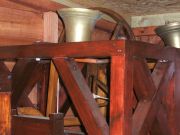
This picture of the Titanic Bell shows it in the raised position with the Abbey Bell behind, also in the raised position.
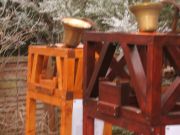
This image shows Titanic Bell flanked by Number 33 Bell, both raised the frame of Titanic Bell is much taller and wider than Number 33's frame, that was one of the many improvements made when bell hanging became more refined- smaller, lighter frames, the size of Titanic Bells frame is not needed to house a bell of Titanics size, the frame of Number 33 Bell is more in proper proportion with the size of the bell.
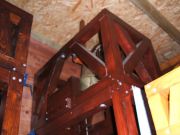
Image shows Titanic Bell from below.
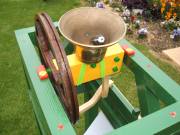
The Olympic Bell, raised, the stay can clearly be seen resting against the slider.
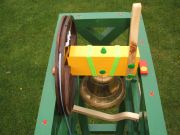
Another view of the Olympic Bell, this time in the lowered position, the screws which hold the whole thing together are painted red along with the bearing caps which goes well with the green frame.
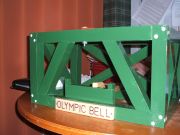
This image shows the Olympic Bells frame, although the side which houses the slider running block has cross braces, the widths and one of the lengths of the frame have 'cross-halving joints'- these are the supports for the frame along with cross braces but take a lot longer to measure and cut than the more commonly used cross brace, only a handful of all the models both Mini Rings and Single Bell Frames contain cross-halving joints.
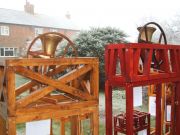
Monastery Bell (right) along side Abbey Bell, both rung 'up', the length of the frame is noticably longer than that of the Abbey Bell, Monastery Bell weighs
4lb. 4oz while Abbey Bell weighs 3lb. 3oz.
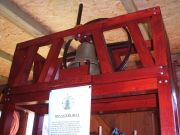
As the length of this bells frame is longer than normal, it has been double cross braced as we can see above meaning instead of two cross braces on each side, we now have four, such supports make a structure like this extreamly strong- with the frame on the ground it could carry the weight of six people!.
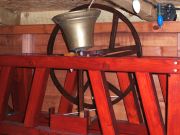
This partial view above shows Monastery Bell in the raised position, this bell has a very nice sound to it as being cast of Bronze instead of mainly Brass bells, it emits a less 'tinny' dong.
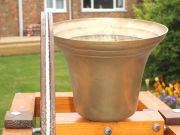
This partial image of the Number 33 Bell shows it in its 'up' position, the dark oak wheel, stay and bearing caps contrast well with the 'Antique Pine' headstock and framework.
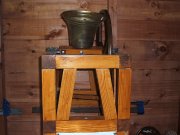
Another partial view of Number 33 Bell this time it is raised or 'up'.
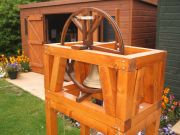
The above image of Number 33 Bell shows it in its 'down' or lowered position, the slider can clearly be seen below the wheel.
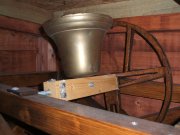
A partial view of the Abbey Bell in its raised position, steel gudgeons can be seen which replaced the early wooden gudgeons, the bearing caps are made of plywood.
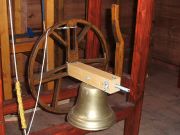
This picture of Abbey Bell shows it out of its frame, the stay gudgeon is visible and this model has a curved stay unlike some models which have a straight stay.
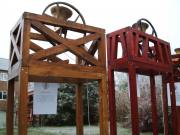
Abbey Bell and Monastery Bell stand side by side, both are rung up, the Monastery Bell is one pound heavier than Abbey Bell and is cast of Bronze unlike Brass.
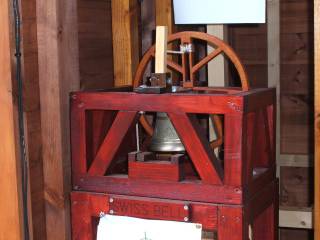
A view of the Swiss Bell, the 'staybox' can clearly be seen with the stay protruding from it, time consuming and difficult to make, thats why only one model has a staybox- the Swiss Bell.
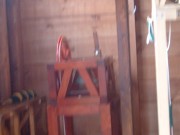
This above, slightly blurrey image is of the original 'Red Bell' with its first wheel, headstock and stay, all this would be replaced with much improved woodwork although the Red Bell still exists and is waiting to be re-hung in a new frame which will be named the Red Bell. The original wheel was bright red- thats why this model was once called the 'Red Bell'.
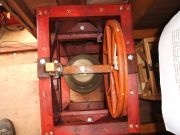
A birds-eye view of the Swiss Bell, with the stay box on the left hand side of the headstock opposite the wheel. This model was far more 'rustic' and untidy when it was named 'Red Bell', the re-fit has improved it immensly.
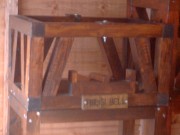
This image is of the Tbilisi Bells frame, the slider and its running block are visible while the bell assembly is missing, the cross braces are complete and the bearing caps are in place.
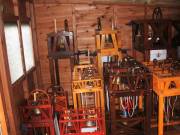
The models how they look when living in the 'Bell shed', this photo was taken before several of the more recent models were built. The Tbilisi Bell is at the back on the far left.
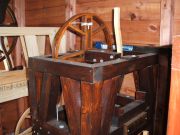
The Tbilisi Bell in the down position, unlike other models where the headstock is made of pine, this bells headstock is of solid oak for extra strength as this bell is the second heaviest bell at 8lbs 2oz.
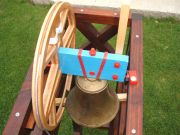
This image above is the Saxon Bell in the lowered position, the blue headstock is clearly visible with its clear wheel and stay and red bearing caps and metalwork. As the Bells down at East Bergholt have blue headstocks and red metalwork, this bell was designed to replicate one so it to has a blue headstock and red metalwork.
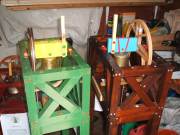
The Olympic and Saxon bells stand together with the Swiss Bell in the background, the framework of the Olympic bell is paint while the Saxon bells frame is of dark oak varnish.
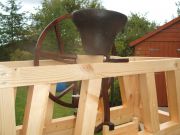
The North Bucks Bell in the raised position, the frame is double cross braced to add strength, also the frame has been lengthened to help keep the model more stable when ringing.
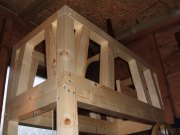
This image is taken from below and shows the North Bucks Bell with its very strong frame and supporting scaffold.
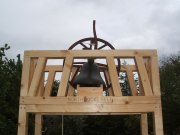
Another image of the mighty Norths Bucks Bell, the frame is over 36 inches long and stands over 6 foot tall.
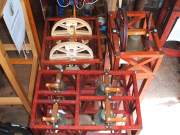
This picture shows the Priory Bell on the top, right hand corner with the Minimus Four and the Crossroad Bells Mini Rings.
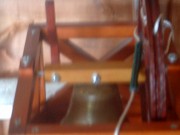
Partial view of Priory Bell with cross halfing joint visible behind the bell assembly.
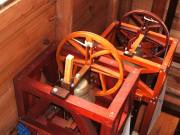
This picture is of the Swiss and Priory bells standing side by side, the compact size of these models makes them perfect for transportation and carrying.
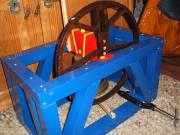
This partial view of the Bitannic Bell was taken shortly before completion, it shows the unusual blue framework- paint has been used instead of varnish.
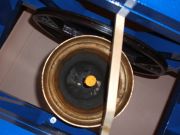
A birds-eye view of Britannic Bell with the clear slider bar below the bell, the bells clapper has been painted yellow as well has the screws, nuts and bolts of the framework and headstock.
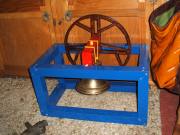
The Britannic Bell above, unfinished this bell has no stay or slider and the frames cross braces are yet to be fitted, also the bearing caps have not been cut yet and the slider running block is still to be made.
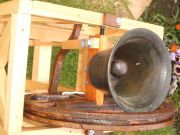
A view of the Table Bell in the 'up' position, this image shows how the stay engages the slider, enabling the bell to set in the inverted position.
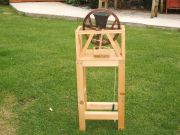
This image of Table Bell shows how small it is compared to the other models, not more than 2 ft tall. The bell is raised in the 'up' position.
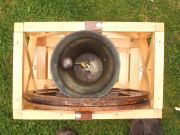
The Table Bell in the 'up' position, the clapper has been greased where it hooks onto the independant loop, greasing makes the clapper move more freely, the bearings are also greased to aid in their movement.
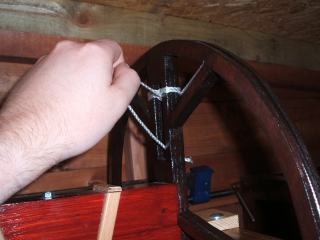
The South Bucks Bell is having its rope tied onto the wheel, the rope has to be long enough for it to wind around the entire circumferance of the wheel. Attaching the rope is the final step in making the model, once that is finished the model is finished!.
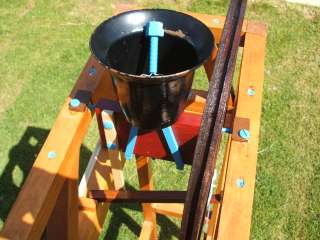
Fools Bell above is very light and emits a very 'tinny' sound (being made of Tin!.)
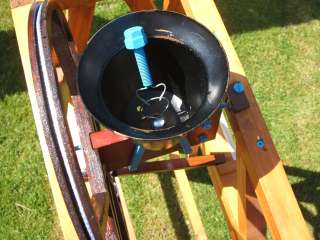
Because Fools Bell is very light for its size, the frame does not have to be as big or as strong as some of the other frames.

Compared to Number 33, Titanic and Monastery Bells, Fools Bell (bottom right)is small and weighs a fraction of the larger bells.
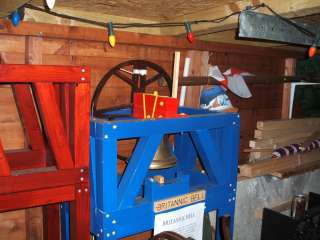
The Britannic Bell as it sits in the 'Bell Shed' with its neighbour the Monastery Bell.
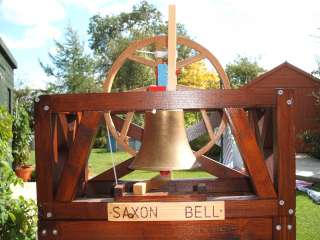
As with the Britannic Bell the Saxon Bell has a painted Headstock, but unlike the Britannic Bell's painted blue frame the Saxon Bell's frame is varnished in the 'Dark Oak' style.
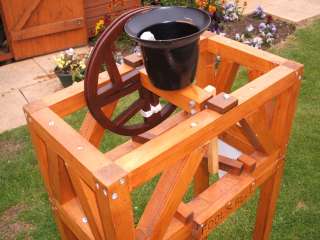
Fools Bell is cast of Tin which means it is very light for its size, some bells which are half the size of Fools Bell can be as heavy or even heavier.
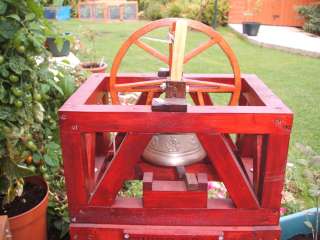
The Swiss Bell's frame used to contain a different bell, known as the 'Red Bell' but a new bell was installed with a new wheel, headstock and stay and re-named 'Swiss Bell'.
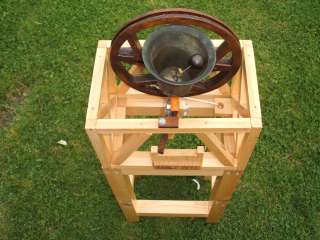
Being only eighteen inches tall and eight inches long, the Table Bell is the smallest of all the models, such a small model can be very useful to transport and display due to its small size and weight.
|

Single Bell Frames
A 'Single Bell Frame' is a model which contains only one bell.
 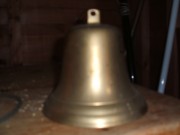
Just as with a Mini Ring, a Single
Bell Frame starts with just the bell.
The top image above is of the 'Britannic Bell', An almost six foot tall model containing a brass bell which weighs 3lb 3oz and is 7 inches high.
Titanic Bell
The 'Titanic Bell' is the oldest of all the model church bells, built in October 2005, this model was very much experimenting with model making and bell hanging techniques, with all the experience gained after three and a half years of model bell hanging since October 2005, the models now are far more refined in the quality and workmanship of the individual parts- a bell wheel made in the past year would be of much greater quality than a wheel made in 2005 or 2006, everytime a model is made it is slighty more improved than the last although a state of perfection has now been just about reached with wheel cutting, frame design, varnishing etc. Back in 2005-06 all of the what is mentioned above was very much 'uncharted waters' and as the entire technique of model bellhanging was transformed over the many months, a way of improving the earlier models was to replace the early 'prototype' wheels, and other parts of the bells assembly- many of the older models like the Titanic,
Abbey, Fools had major re-fits with new wheels, stays, sliders, even new headstocks in some cases which improved them spectactually.
Titanic Bell
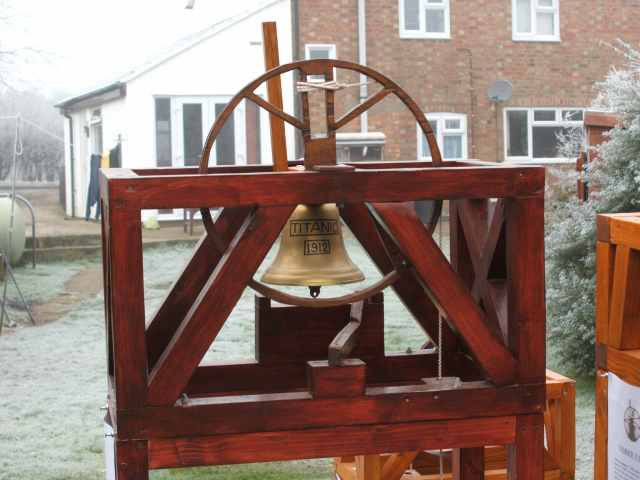
Olympic Bell
Unlike the Titanic Bell above, the Olympic Bell was made far more recently in March 2009. Instead of varnish being used to colour the model, paint has been applied- Holly Green for the frame and a bright yellow for the headstock, varnish has been used for some parts of this model, for the stay, wheel, slider. Painting a frame is much more time consuming than using varnish as undercoat paint has to be applied before the green top coats- the top coat had to be left for an agonising 16 hours in between the two coats while varnish can be re-coated in just 1 hour- quite a difference!. This model was named 'Olympic' because the famous steam ship RMS 'Titanic' which sank on its maiden voyage after a collision with an iceberg in 1912 had two 'sister' ships- one named the 'Olympic' and the other named 'Britannic'. As there is a model bell named 'Titanic' it seemed only fitting to build two other models named 'Olympic' and 'Britannic'.
Olympic Bell
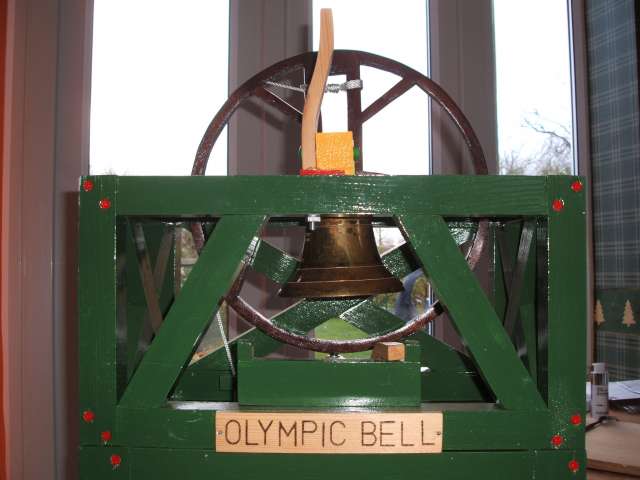
The Olmypic Bell Has A New Wheel
When the Olympic Bell was made in March 2009 it had a seven inch wheel (diametre), this was deemed as too small in proportion to the length and height of the frame although it wasn't until November 2009 that it was decided to retro-fit the model with a much larger wheel. This new wheel as seen in the above image is thirteen inches in diametre- almost twice the size as the original smaller wheel and allows the bell to swing further with each pull of the rope. The bell seems very small compared the the new wheel but smaller bells do have a large wheel in order for them to swing further.
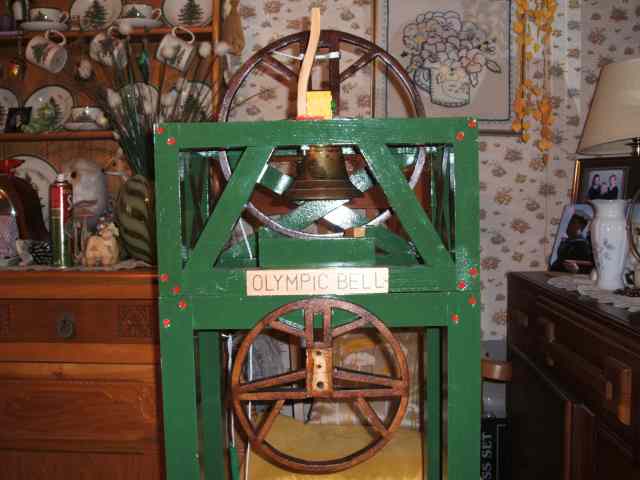
This picture above shows 'Olympic Bell' with its new wheel and its previous smaller wheel hanging below the frame, a bigger wheel makes for better ringing.
Monastery Bell
Back in September 2006 a model was constructed to be installed in a loft space with a rope coming through the ceiling to enable the bell to be rung from a bedroom. As this model was rarely going to be seen the frame went un-varnished, but after only a couple of days its was clear that the bell wasn't going to ring properly due to the space around the frame being too small so the model was removed. Being placed back among the other models, the frame was varnished as it would have been if it had not been intended for use in a loft and a scaffold for the frame was built and varnished. As we can see, the frame is very long compared to the size of the bell- its length being 32 inches, the loft beams from where this model was intended were 16 inches apart, 16 inches would have been too short for a frame so it was hung across three loft beams- 16+16=32 inches so thats how long the frame had to be as it needed to be bolted to the beams in order for it to not move about during ringing. This model is one of two very large frames, standing over 6ft tall.
Monastery Bell
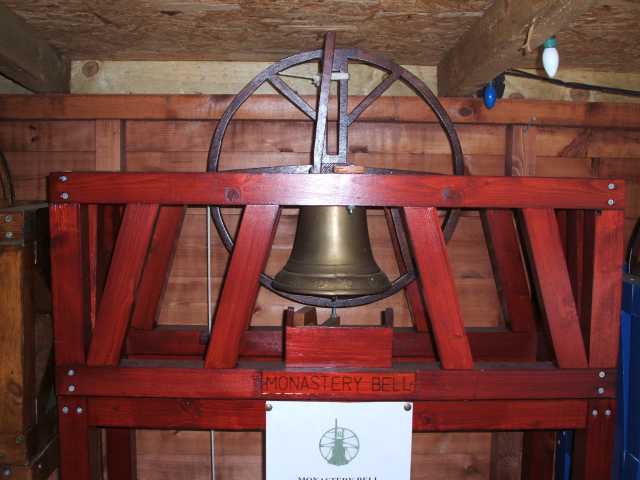
Number 33 Bell
This Bell which weighs 3lb 3oz was built in January 2007, it was named 'Number 33 Bell' because at that time it was the thirty-third bell hung. As this bell is cast of Brass, it emits a slightly 'tinny' sound when being rung but not as 'tinny' as some of the other Brass bells. When any model is being made, designing the 'slider' can be difficult- the idea is that the 'stay' can coincide with the slider without the bell making contact with the slider as well, with Number 33 Bell the slider and the bells soundbow come within millimeters of each other- they almost touch but luckily the stay can move the slider without the bell moving the slider as well.
Number 33 Bell
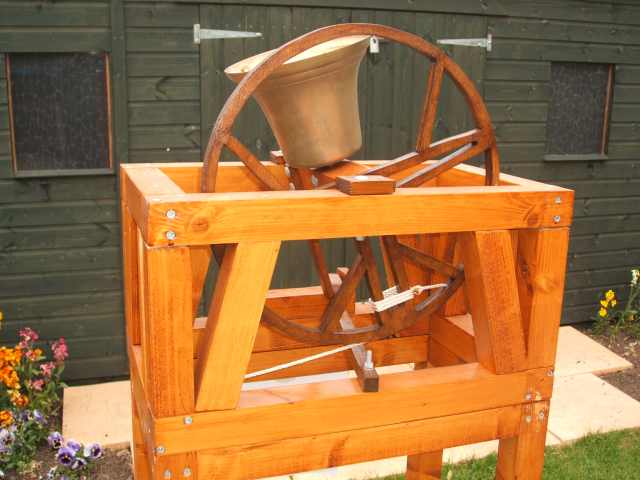
Abbey Bell
This bell along with the Titanic bell are two of the oldest models, most of this model was built in November 2005 but as with other early models a re-fit was undertaken as improvements in detail and quality evolved as time went on, a new wheel was made which was bigger and neater and the wooden dowel gudgeons were replaced with gudgeons made of steel, also the frame was improved and far better bearing caps were made. Abbey Bell is the same size and weight as Number 33 and Britannic Bells but has a slightly different tone as when casting the bells, the consistancy of brass in each bell is slightly different from each other which gives each bell a slightly higher or lower pitch than the other, but still being identical in size and weight, Abbey Bell weighs 3lb 3oz.
Abbey Bell
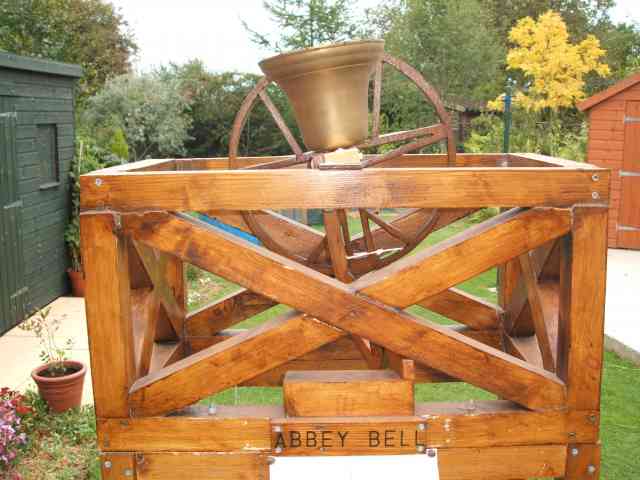
Swiss Bell
An unusual feature of this model is that it incoporates a plywood 'Staybox' instead of the stay being bolted onto the side of the headstock like all the other models, a small plywood box has been made- this is for the stay to sit in while a bolt passes through the box and stay to hold the stay in place. These stayboxes are far more time consuming to make compared to just bolting the stay onto the headstock and are of only limited strength, a heavier model such as the North Bucks Bell would generate enough force to split the staybox open when the stay bumps the slider as these stayboxes are held together only by small pins. Another unusual feature of this model is the original wooden gudgeons- only Caters Campanile has gudgeons made of wooden dowel, the rest have steel gudgeons. As this frame was an earlier model made in mid 2006, it has been improved with a new wheel, stay etc like the other earlier models, but unusually this model had a new bell!- the previous bell was smaller and made of steel and the model was named the 'Red Bell', the new 'Swiss Bell' was heavier than the old Red Bell so it replaced it during the re-fit and the model was re-named 'Swiss Bell', a model which has had two different bells in its lifetime is unique and named the 'Swiss Bell'.
Swiss Bell
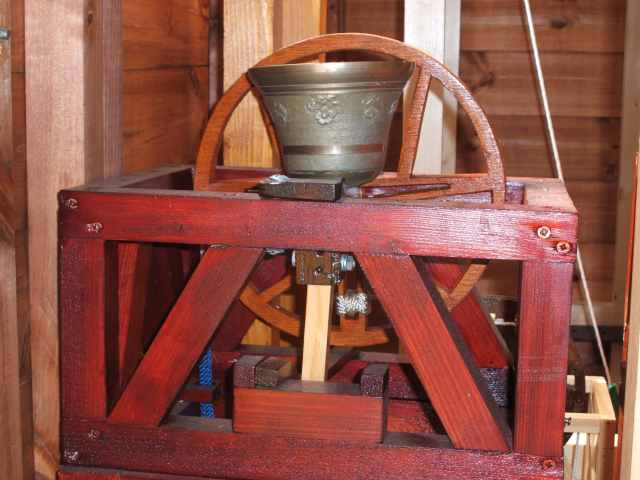
Tbilisi Bell
When this model was made in June 2006, the Tbilisi Bell weighed a little over eight pounds making the heaviest bell hung at that time, however, the North Bucks Bell has overtaken the Tbilisi Bell as the heaviest bell, North Bucks Bell weighs 9lb 4oz but back in 2006 the Tbilisi Bell was twice the weight of the second heaviest the Monastery Bell. The Tbilisi Bell was named as so because it comes all the way from Tbilisi, the capital city of Georgia which was once part of the former Soviet Union. This bell had to have its gudgeons set over an inch and a half into its solid oak headstock as the force that is produced while this bell is ringing is rather a considerable one- its slider was snapped in two during its construction by the stay banging too hard against it.
Tbilisi Bell
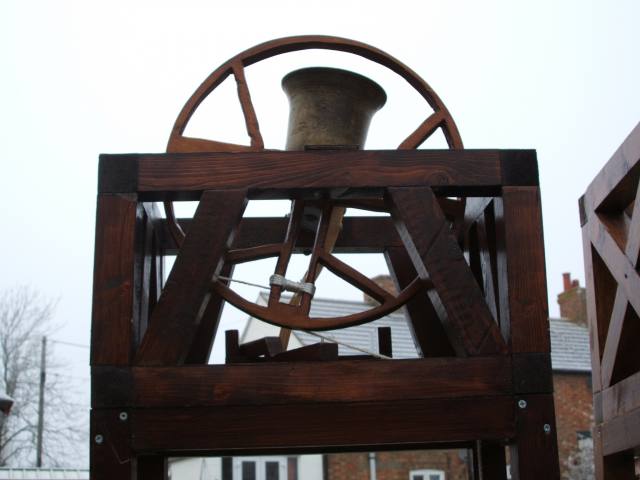
Saxon Bell
Back in the days before the Bergholt Doubles Mini Ring was made, a model was built to replicate one of the unique East Bergholt ground level bells, this model was an East Bergholt replica but when the Mini Ring 'Bergholt Doubles' was built it was decided that this model was to be converted into a traditional tower bell, so a wheel, stay and slider were made but the frame had to be widened in order for a wheel to fit. Once this was fully converted it was named 'Saxon Bell' , its blue headstock being a reminder of what this model was originally designed as and it began the trend for using paint to colour the woodwork instead of varnish, although most of this model is coloured with varnish. The Britannic and Olympic bells are mostly painted rather than varnished, a process which takes considerably longer than using quick drying wood varnish.
Saxon Bell
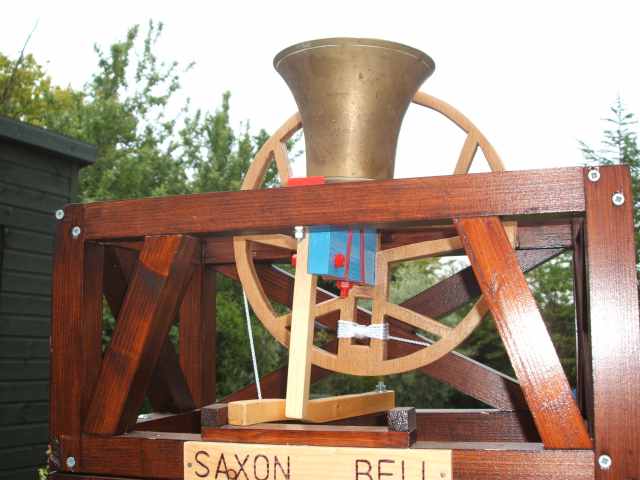
North Bucks Bell
This is the biggest and heaviest bell hung to date, weighing 9lb 4oz North Bucks Bell is almost ten times the weight as 'Fools Bell' and around forty times the weight as the treble (smallest bell) of the White Wheel Doubles Mini Ring. This model has to be bolted firmly to the frame of the shed from where it lives in order not to fall over during ringing, the clapper itself is over 1 1/2 lb in weight. Care has to be taken when ringing this model as too much force will break either the stay or slider as this bell generates nearly forty pounds of force when in motion, it stands over six foot four inches tall and dwarfs many other models, this model was built in June 2008 and will probably remain the heaviest bell out of all the models.
North Bucks Bell
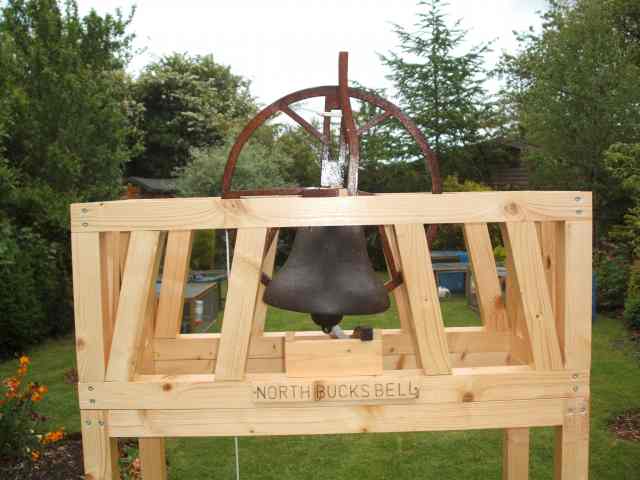
Priory Bell
With models such as 'Titanic', 'Monastery' and 'Abbey' Bells, they all have one thing in common- their size, because these models are large and heavy transporting them and carrying them can present quite a challenge. So a series of small one bell models were designed, small enough to be moved around easily these models were ideal for demonstation and exibiting. Priory Bell was one of the first of these smaller models, normally the Mini Rings would contain small bells and Single Bell Frames would contain larger, more heavier bells. The smallest model is the 'Table Bell' which is no more than twenty inches tall and ten inches wide and contains one small brass bell. Priory Bell has a fair array of colours with a dark red wheel and stay, dark oak slider and antique pine headstock, instead of cross braces the frame has cross halfing joints which are more difficult to make and far easier to get wrong. This model was completed in October 2006 and since then a couple more small single bell frames have been made.
Priory Bell
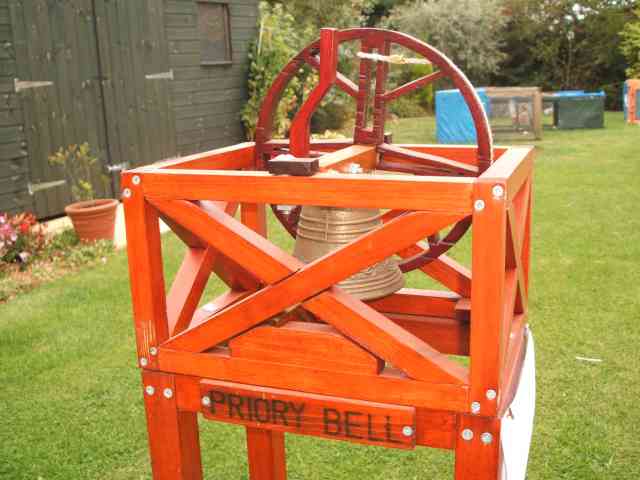
Britannic Bell
Before the Britannic and Olympic bells were built, the woodwork of each model was coloured with varnish but as each of the shades of varnish had been used on at least two previous separate models, it was decided to use paint rather than varnish in the construction of the Britannic Bell. As a result of painting most of the woodwork, this model took far longer than normal to make as the wood had to be undercoated with two coats and top coated with two coats, the top coat took an agonising sixteen hours to dry in between coats when wood varnish would take only one hour to dry. All the waiting was worth it as this model has a 'Royal Blue' finish instead of the usual varnished finish and stands out among the other models with its unusual colour. As most of the bells metalwork has also been painted- screws, bolts etc, they had to painted after they were fitted onto the woodwork, so when the stay had been bolted into position, the nuts and bolts were painstakingly painted with extreme care in order not to get any paint on the headstock or framework, as were the screws that holds the frame together. This bell weighs 3lb 3oz and is made of Brass.
Britannic Bell
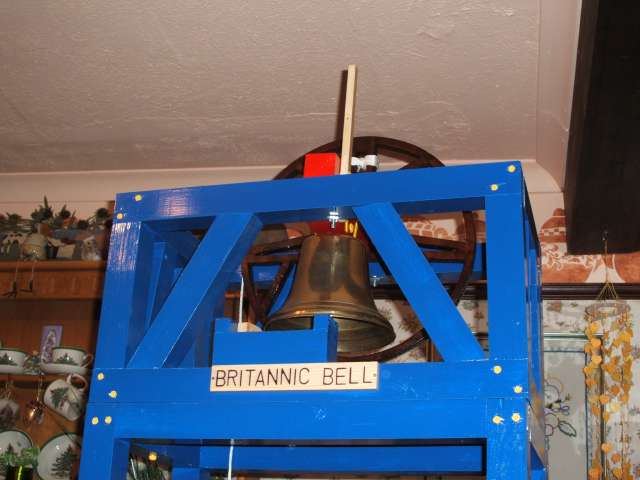
Fools Bell
Fools Bell is a very lightweight bell for its size because it is cast of tin, although it is almost the same size as the Tbilisi Bell, Tbilisi Bell weighs eight times as much as Fools Bell. Tin is a very light metal and the sound made by a tin bell is relatively poor compared to other bells which are cast of Brass or Bronze etc, weighing only 1lb this bell is lighter than Brass bells only half its size, for example, the number four or five bell in the Mini-Ring 'Oakslider Doubles' will be as heavy or even heavier but only half the height and width of fools Bell. This model was made in January 2006 but re-fitted with a new wheel, stay, slider and rope etc in June 2007, also several alterations where made to the frame. Another major re-fit has just been completed with the wheel, stay, slider, headstock, clapper and gudgeons all being replaced with improved 'bell gear'- stay, slider, wheel etc.
Fools Bell
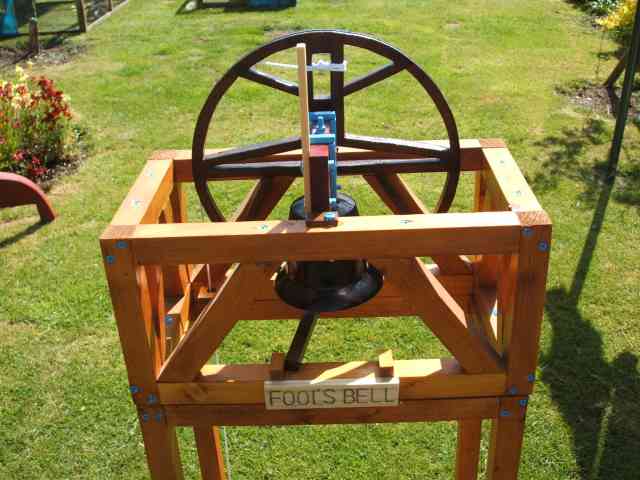
Table Bell
This model is the smallest model made so far, with some of the larger models being over six foot tall this model is tiny- no more than 2ft tall and ten inches long by seven inches wide (approx). This model was made to be easily transportable and space saving, the larger models are more difficult to carry about. The bell is cast of Brass and is adorned with a 'antique pine' headstock, a 'dark oak' wheel along with a clear stay, the frame is also clear and has a 'dark oak' slider, cross halfing joints have been cut along with cross braces. Table Bell was named as so because of its small size it could be easily placed onto a table for demonstration purposes. This model is one of the few that is small enough to 'live' inside another larger model, that means it is narrow enough to fit inside the supporting scaffold of a much larger model such as the 'North Bucks Bell' and so when they are in the 'bell shed', Table Bell lives inside another model which gives more space for the other models.
Table Bell
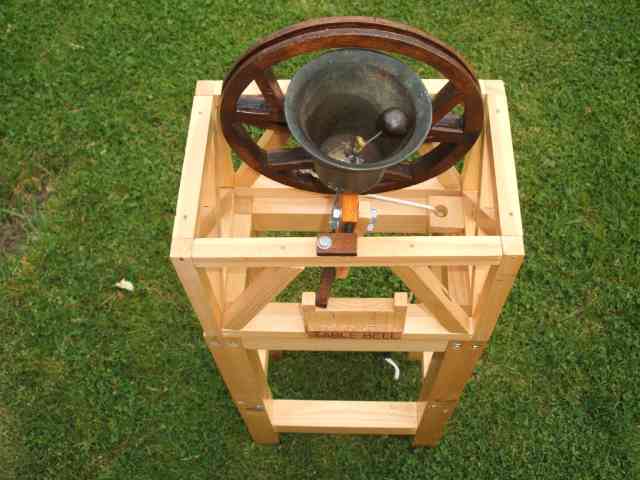
South Bucks Bell
This model is the latest model to be built, completed on 1st September 2009- almost four years to the day since the very first model was made back in 2005. As with the North Bucks Bell this bell is very heavy compared to the other models, it weighs 9lb 4oz- joint heaviest with the North Bucks Bell and can only be rung properly by clamping the frame to the main frame of the shed in which the models live as this model creates alot of sideways force when swinging, about 40lbs. Because of the bells weight, certain parts of the model have to made stronger than normal to cope with the force and weight of the bell, for example, the gudgeons or swivels which enable the bell to swing have to be inserted deep into the headstock- about one and a half inches to avoid them failing and the whole bell gear falling from its frame, the clapper staple (the loop inside the bell which the clapper is hooked onto) has to be glued right through the crown or top of the bell and be firmly secured into the headstock. The clapper of both the North and South Bucks Bells are heavy, they weigh around 2lb which is heavier than many of the small bells in other models.
South Bucks Bell
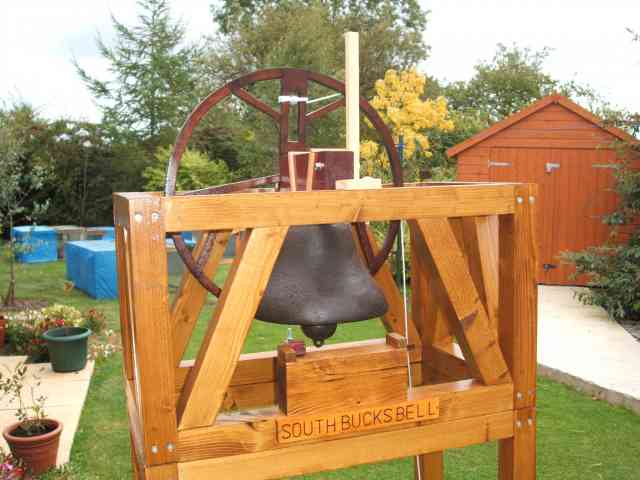
Chapel Bell
The very latest model to be built, Chaple Bell has a couple of features which are unique among all of the models made so far. Up until the building of the Chapel Bell each model has had its bell or bells suspended in the frame by means of two notches being cut into the top of the frame or 'pit' to allow the bells gudgeons to rest in, the Chapel Bell is unique because for the first time the bell, headstock and wheel sit on top of the frame rather than in 'gudgeon wells' cut into the frame as with every previous model made.
Up until the building of this particular model the frame's of all the Mini-Rings and Single Bell Models have been made of softwood which is perfectly square- the height and width of all of the wood used in the making of each frame has been the same, for example- 15mm x 15mm, 32mm x 32mm and 45mm x 45mm etc, the frame of the Chapel Bell has been made of stripwood which is rectangular, 12mm x 24mm in dimension. This makes the frame look more unusual than the others and presented unique challenges during construction. The bearings had been made separately to the frame out of mainly pine with plywood sides and covers to cover the gudgeons, these bearings sit on top of the frame and support the bell and its headstock.
Instead of the more common 'Cross-Brace' being used to give the frame extra support, 'Cross-Halfing Joints' have been used, these take considerably more time to cut and are far more difficult to measure, cut and install. The headstock has been painted white instead of being varnished and has been supplemented with red canon-straps, nuts and bolts and gudgeons, the frame is coloured 'antique pine' with 'dark oak' Bearings and Stay and a clear coloured Slider. When the 'Olympic Bell' has its wheel replaced with a much larger one several months back, its old wheel was kept and fitted onto the Chapel Bell. The time taken to built this latest model was some what reduced due to a wheel being already available and not having to be specially made. This model was built in February-March 2010 and took just over two and a half weeks to complete.
The Chapel Bell
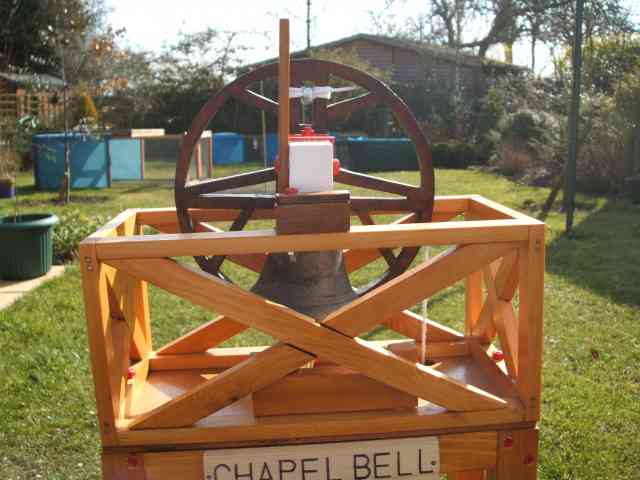
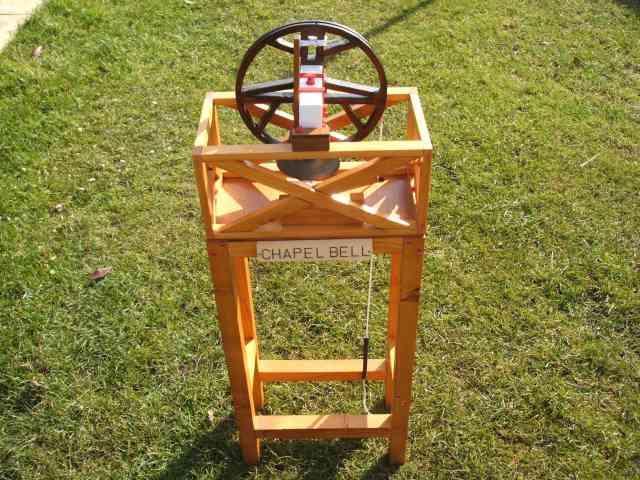
Because the Single Bell models are usually much larger than the bells which are hung in Mini Rings- the heaviest bell which hangs in a Mini Ring is the Tenor of Monks Minor which weighs no more than 1lb 7oz, most of the Single Bell Models are 2lb or more, far more realistic ringing can be achieved with a heavier bell and models like 'Britannic Bell' will ring full circle just like a full size tower bell weighing half a ton would ring. As the bells in Mini Rings are fairly small, they are simply too light to swing 'full circle' and are built solely as demonstration models.

The 'Action Man Bellringer'
An Action Man is the perfect scale for the size of a bellringer in proportion to the size of the bells, some bells are as tall as the ringer while some a no more bigger than a waste paper basket, The bell which the Action Man is 'ringing' here is the South Bucks Bell.
|